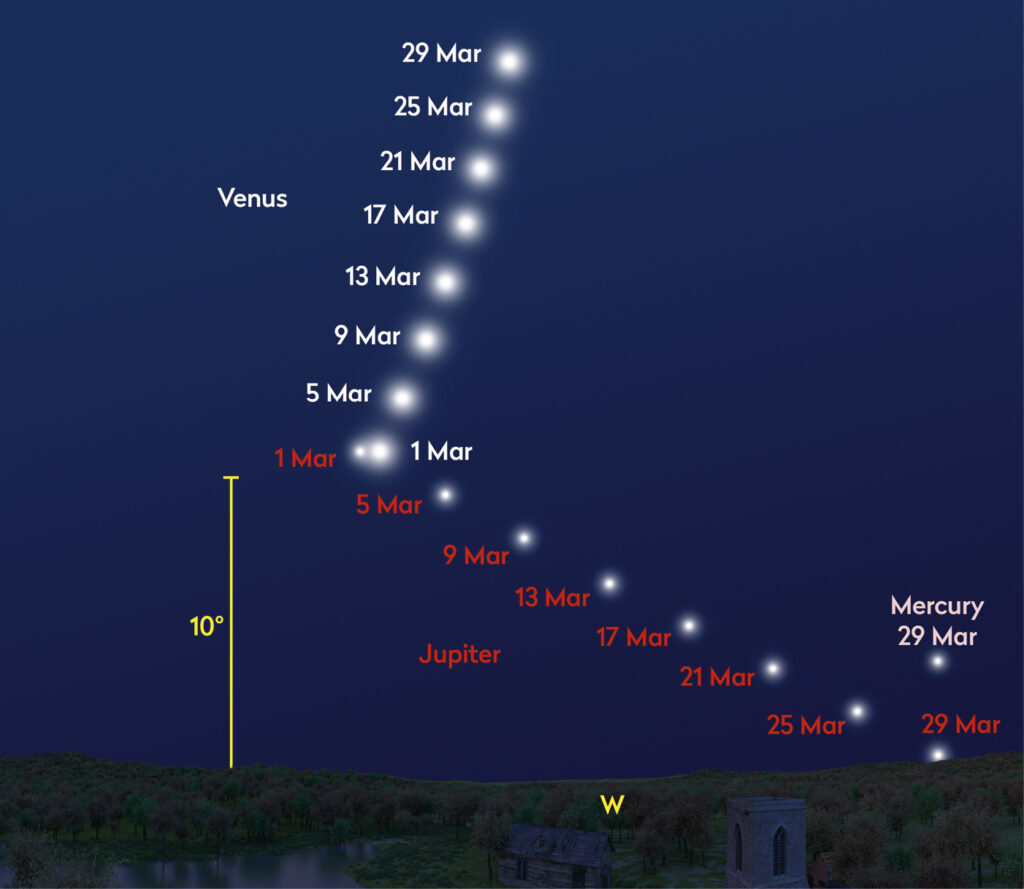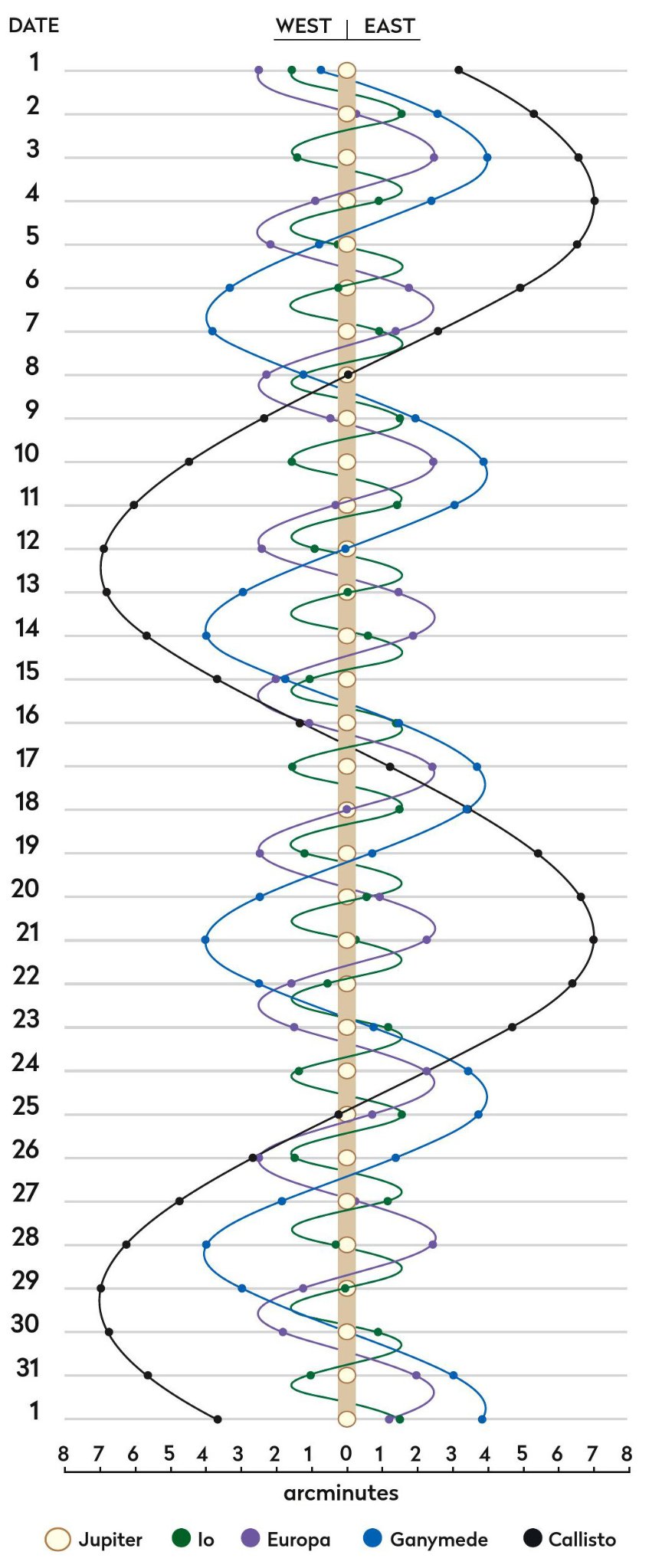Our celestial neighbourhood in March
PICK OF THE MONTH
Venus
Best time to see: 31 March, from 1 hour after sunset
Altitude: 22°
Location: Aries
Direction: West
Features: Phase, subtle atmospheric shadings
Recommended equipment: 75mm or larger

Mag. –3.9 Venus sits really close to mag. –2.0 Jupiter at the start of March, the two planets appearing 38 arcminutes apart on 1 March and 46 arcminutes apart on 2 March. Using a telescope for the encounter, Venus will be showing an 85%-lit phase and appear 12 arcseconds across, while Jupiter will appear nearly three times larger at 34 arcseconds across. It will be interesting to try to grab a view or photograph of the pair through a telescope with both planets showing their discs. The pair set nearly three hours after the Sun at the start of March.
Venus and the crescent Moon are always a popular sight in the early evening sky; they would be equally as popular when in the morning sky, were it not for the fact that you have to get up early to see such an encounter! A slender 5%- lit waxing crescent Moon appears near Venus on 23 March, with a second chance available on 24 March when the slightly thicker 9%-lit waxing crescent appears even closer to the mag. –3.9 planet.
A second planetary encounter occurs on 30 March but, it has to be said, this event will be less impressive than the Venus–Jupiter conjunction at the start of the month. On 30 March, Venus lies 1.2° from dim Uranus. The magnitude disparity between –3.9 Venus and +5.8 Uranus represents a brightness difference of around 7,500 times.
Throughout the month, Venus can be seen against a truly dark sky, which only helps to emphasise how bright this beautiful planet appears. Its altitude will be low at the start of March. By the end of the month Venus remains above the horizon for 220 minutes after sunset.
Mercury
Best time to see: 31 March, 40 minutes after sunset
Altitude: 6° (low)
Location: Pisces
Direction: West
Mercury begins March poorly located in the morning sky. Superior conjunction occurs on 17 March, after which Mercury reemerges favourably into the evening sky. On 24 March, mag. –1.5 Mercury sets 40 minutes after sunset. Mercury and Jupiter are close at the end of the month, appearing 1.5° apart on 27 March. Mercury is mag. –1.3 on this date. By the end of the month, at mag. –1.1, Mercury’s separation from the Sun increases and it now appears above Jupiter, setting 85 minutes after sunset.
Mars
Best time to see: 1 March, from 19:25 UT
Altitude: 61°
Location: Taurus
Direction: South
Mars is fading as its distance from Earth increases. On 1 March, the mag. +0.4 evening planet presents a disc 8 arcseconds across through the eyepiece. This is still large enough to present detail through larger scopes, but it is getting harder. By the end of March, Mars shrinks to 6 arcseconds across and dims to mag. +0.9. On 30 March, Mars appears 1.2° from the mag. +5.1 open cluster M35.
Jupiter
Best time to see: 1 March, from 19:00 UT
Altitude: 15°
Location: Pisces
Direction: West
Jupiter puts on an early March naked-eye display with bright Venus. On 1 March, both bright planets appear separated by 38 arcminutes, and while on 2 March they part slightly, they still remain around 0.75° apart. Venus will be at mag. –3.9 and Jupiter at mag. –1.9.
After this, Jupiter rapidly moves into the evening twilight. On the evening of 22 March, Jupiter sits 1.8° above a 1%-lit waxing crescent Moon, visible low above the western horizon 30 minutes after sunset. Jupiter appears 1.5° from mag. –1.3 Mercury on 27 March.
Saturn
Unlikely to be seen in the morning sky
Saturn is a morning planet, badly placed throughout the month and unlikely to be seen.
Uranus
Best time to see: 1 March, from 19:40 UT
Altitude: 37°
Location: Aries
Direction: West-southwest
Uranus’s position deteriorates rapidly this month. On 1 March it shines at mag. +5.8 and binoculars are recommended to see it. Uranus has an altitude of 37° as true darkness falls. By the end of March, this value drops to just 12°. Uranus has a close encounter with Venus on 30 March, dim Uranus 1.2° from mag. –3.9 Venus at 20:40 UT. A slender 12%-lit waxing crescent Moon sits slightly less than 2° from Uranus on 24 March, as they both approach the westnorthwest horizon.
Neptune
Not visible this month
Neptune is in conjunction with the Sun on 15 March and not visible this month.
More ONLINE
Print out observing forms for recording planetary events
www.skyatnightmagazine.com/bonus-content/UTDXPBX
The planets in March
The phase and relative sizes of the planets this month. Each planet is shown with south at the top, to show its orientation through a telescope

Jupiter’s moons: March
Using a small scope you can spot Jupiter’s biggest moons. Their positions change dramatically over the month, as shown on the diagram. The line by each date represents 00:00 UT.
